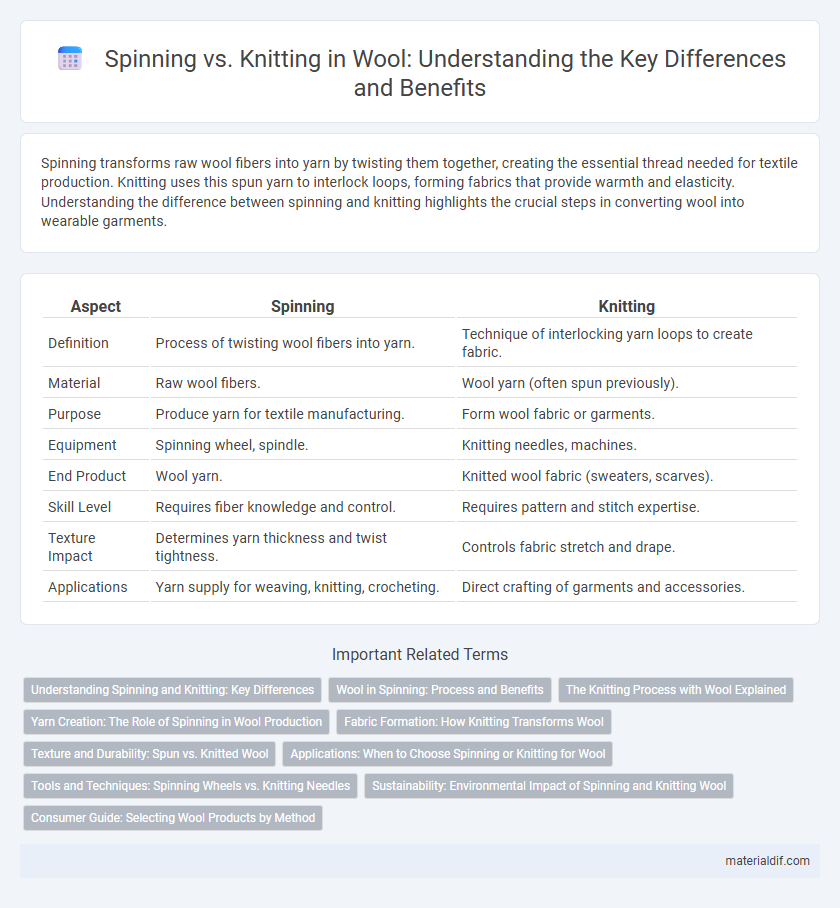Spinning transforms raw wool fibers into yarn by twisting them together, creating the essential thread needed for textile production. Knitting uses this spun yarn to interlock loops, forming fabrics that provide warmth and elasticity. Understanding the difference between spinning and knitting highlights the crucial steps in converting wool into wearable garments.
Table of Comparison
| Aspect | Spinning | Knitting |
|---|---|---|
| Definition | Process of twisting wool fibers into yarn. | Technique of interlocking yarn loops to create fabric. |
| Material | Raw wool fibers. | Wool yarn (often spun previously). |
| Purpose | Produce yarn for textile manufacturing. | Form wool fabric or garments. |
| Equipment | Spinning wheel, spindle. | Knitting needles, machines. |
| End Product | Wool yarn. | Knitted wool fabric (sweaters, scarves). |
| Skill Level | Requires fiber knowledge and control. | Requires pattern and stitch expertise. |
| Texture Impact | Determines yarn thickness and twist tightness. | Controls fabric stretch and drape. |
| Applications | Yarn supply for weaving, knitting, crocheting. | Direct crafting of garments and accessories. |
Understanding Spinning and Knitting: Key Differences
Spinning transforms raw wool fibers into yarn by twisting them to create strength and uniformity, while knitting uses that yarn to construct fabric through interlocking loops. Spinning determines the yarn's thickness, texture, and durability, directly influencing the final textile quality. Knitting provides elasticity and pattern versatility, making it ideal for garments requiring stretch and intricate designs.
Wool in Spinning: Process and Benefits
Spinning wool transforms raw fleece into yarn by twisting fibers to enhance strength and consistency, crucial for high-quality textile production. This process preserves the natural elasticity and warmth of wool, making spun yarn ideal for durable fabrics and insulation. The ability to control fiber thickness during spinning allows for versatile textures in finished wool products, optimizing both comfort and functionality.
The Knitting Process with Wool Explained
The knitting process with wool involves interlocking loops of yarn using needles to create a flexible fabric ideal for garments and accessories. Wool's natural elasticity and warmth enhance the knitted structure, offering breathability and insulation, which are essential for cold-weather clothing. Unlike spinning, knitting transforms spun wool yarn into intricate patterns and textures, maximizing the fiber's softness and durability.
Yarn Creation: The Role of Spinning in Wool Production
Spinning transforms raw wool fibers into yarn through a process of twisting and drawing, providing the essential strength and consistency required for textile creation. This technique directly influences yarn thickness, texture, and durability, which are critical factors in the quality of the final wool product. Unlike knitting, which shapes fabric by interlocking yarn loops, spinning serves as the foundational step in wool production by creating the yarn itself.
Fabric Formation: How Knitting Transforms Wool
Knitting transforms wool by interlocking loops of yarn, creating a fabric that is highly elastic and breathable, unlike spinning which primarily twists fibers into continuous threads. This looped structure enhances wool's natural insulation and moisture-wicking properties, making knitted garments warm yet comfortable. The flexibility of knitted wool fabrics allows for varied textures and patterns, optimizing both function and aesthetic appeal.
Texture and Durability: Spun vs. Knitted Wool
Spun wool features tightly twisted fibers that create a dense, firm texture known for high durability and resistance to wear, making it ideal for heavy-duty garments and upholstery. Knitted wool, formed by interlocking loops, offers a softer, more flexible texture with excellent elasticity but generally less abrasion resistance compared to spun wool. The choice between spun and knitted wool significantly impacts the fabric's performance, with spun wool excelling in strength and longevity while knitted wool prioritizes comfort and stretch.
Applications: When to Choose Spinning or Knitting for Wool
Spinning wool transforms raw fibers into yarn, ideal for creating durable textiles used in weaving, embroidery, and felting applications. Knitting wool yarn produces stretchy, breathable fabrics commonly chosen for garments like sweaters, scarves, and socks due to their comfort and insulation. Select spinning when crafting strong, uniform yarn for structural projects and knitting for flexible, textured clothing designed for warmth and mobility.
Tools and Techniques: Spinning Wheels vs. Knitting Needles
Spinning wool relies on spinning wheels, which transform raw fibers into continuous yarn through twisting, enabling control over yarn thickness and texture. Knitting wool uses knitting needles, typically made of metal, wood, or plastic, to loop yarn into fabric by interlocking stitches, allowing for various patterns and stretchability. Each technique demands specialized tools that directly influence the quality and characteristics of the final wool product.
Sustainability: Environmental Impact of Spinning and Knitting Wool
Spinning wool uses less energy compared to knitting machinery, resulting in a lower carbon footprint during production. Knitting wool garments often involves higher water consumption due to dyeing processes and finishing treatments. Both methods benefit from using organic, sustainably sourced wool to reduce overall environmental impact.
Consumer Guide: Selecting Wool Products by Method
Spinning transforms raw wool fibers into continuous yarn, enhancing strength and uniformity, which makes it ideal for durable wool products like carpets and heavy garments. Knitting interlocks yarn loops to create flexible, breathable fabrics, perfect for lightweight sweaters and soft accessories. Consumers should select spun wool for robust, long-lasting items and knitted wool for comfortable, stretchy apparel that allows for ease of movement.
Spinning vs Knitting Infographic

 materialdif.com
materialdif.com